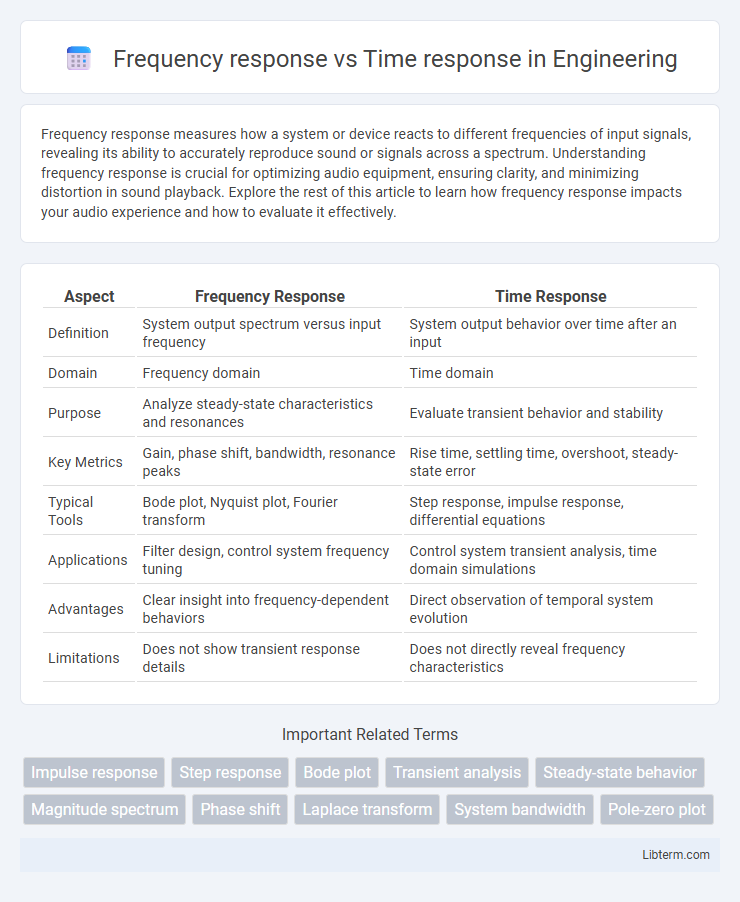Frequency response measures how a system or device reacts to different frequencies of input signals, revealing its ability to accurately reproduce sound or signals across a spectrum. Understanding frequency response is crucial for optimizing audio equipment, ensuring clarity, and minimizing distortion in sound playback. Explore the rest of this article to learn how frequency response impacts your audio experience and how to evaluate it effectively.
Table of Comparison
| Aspect | Frequency Response | Time Response |
|---|---|---|
| Definition | System output spectrum versus input frequency | System output behavior over time after an input |
| Domain | Frequency domain | Time domain |
| Purpose | Analyze steady-state characteristics and resonances | Evaluate transient behavior and stability |
| Key Metrics | Gain, phase shift, bandwidth, resonance peaks | Rise time, settling time, overshoot, steady-state error |
| Typical Tools | Bode plot, Nyquist plot, Fourier transform | Step response, impulse response, differential equations |
| Applications | Filter design, control system frequency tuning | Control system transient analysis, time domain simulations |
| Advantages | Clear insight into frequency-dependent behaviors | Direct observation of temporal system evolution |
| Limitations | Does not show transient response details | Does not directly reveal frequency characteristics |
Introduction to Frequency Response and Time Response
Frequency response analyzes how systems react to different input signal frequencies, revealing amplitude and phase variations crucial for stability and performance assessment in control systems. Time response evaluates system behavior over time when subjected to specific inputs, focusing on metrics like rise time, settling time, and overshoot to determine transient and steady-state performance. Understanding both frequency and time responses enables comprehensive system characterization, essential for designing and tuning control mechanisms effectively.
Fundamental Concepts: Frequency vs Time Domain
Frequency response characterizes how a system reacts to different input frequencies, revealing resonance, bandwidth, and filter properties in the frequency domain. Time response describes the system's output over time when exposed to input signals, highlighting transient behavior, stability, and settling time in the time domain. Understanding the duality between frequency and time domains enables effective system analysis and design for control, signal processing, and communication applications.
Key Parameters in Frequency Response
Frequency response analysis focuses on key parameters such as gain magnitude, phase shift, and bandwidth, which determine how a system reacts to varying input frequencies. These parameters are essential for assessing system stability and resonance characteristics in control systems or signal processing. Understanding gain crossover frequency and phase margin helps predict system behavior under dynamic inputs.
Key Parameters in Time Response
Time response key parameters include rise time, settling time, peak time, and overshoot, which characterize how a system's output evolves after a disturbance or input change. These parameters are critical in assessing system stability, transient performance, and speed of response. Accurate measurement of time response parameters enables optimized control system design tailored to specific dynamic behavior requirements.
Mathematical Representation of Each Response
Frequency response is mathematically represented by the system's transfer function \(H(j\omega)\), which describes output amplitude and phase as functions of angular frequency \(\omega\). Time response is characterized by the system's impulse response \(h(t)\), representing the output signal in the time domain when subjected to a unit impulse input. The Fourier transform links these representations, where \(H(j\omega) = \mathcal{F}\{h(t)\}\), establishing a core relationship between frequency response and time response.
Interpretation of System Behavior
Frequency response characterizes system behavior by revealing how input signals at different frequencies are amplified or attenuated, showing resonance and stability margins. Time response analyzes system dynamics through transient behaviors like rise time, settling time, and overshoot, providing insights into accuracy and speed. Interpreting both responses together enables comprehensive understanding of system performance in frequency and time domains.
Practical Applications in Engineering
Frequency response analysis enables engineers to design and tune control systems by evaluating how systems react to sinusoidal inputs across varying frequencies, crucial for applications like vibration analysis and audio system design. Time response assessment focuses on system behavior following step or impulse inputs, essential for determining stability and transient performance in mechanical and electrical systems such as robotics and power electronics. Both methods provide complementary insights, with frequency response optimizing steady-state performance and time response ensuring desired dynamic behavior in engineering applications.
Advantages and Limitations of Each Approach
Frequency response analysis provides clear insights into system behavior across a range of frequencies, enabling the identification of resonant peaks and stability margins, but it may overlook transient behavior and non-linearities. Time response evaluation captures the system's transient dynamics and settling time, offering detailed performance information under specific input conditions, yet it can be less intuitive for characterizing behavior over a broad frequency spectrum. Each approach balances precision in system characterization with practical applicability depending on whether steady-state or transient performance is prioritized.
Comparison: Frequency Response vs Time Response
Frequency response analyzes how a system reacts to different frequencies, highlighting steady-state output and resonance characteristics, while time response examines how a system responds to a specific input over time, focusing on transient behavior and stability. Frequency response is essential for understanding system behavior in the frequency domain, including bandwidth and phase margin, whereas time response provides insight into rise time, settling time, and overshoot in the time domain. Comparing the two, frequency response offers a global perspective of system dynamics across all frequencies, whereas time response delivers detailed temporal information for specific input signals.
Conclusion & Future Perspectives
Frequency response analysis provides a comprehensive understanding of system behavior across a range of input frequencies, enabling precise design and control of dynamic systems. Time response analysis offers detailed insights into transient behavior and stability under time-domain conditions, essential for real-time applications. Future perspectives emphasize integrating advanced computational methods and machine learning to enhance the accuracy and adaptability of both frequency and time response analyses in complex, nonlinear systems.
Frequency response Infographic

 libterm.com
libterm.com